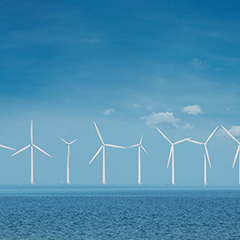As part of the Danish climate agreement of June 2020, it was decided to build two energy islands, in the Baltic and North Seas respectively, linked to offshore wind farms that together can provide 5 GW and cover the electric consumption for approx. 5 million households in Denmark and nearby countries. The global engineering, architecture and consultancy company Ramboll has been awarded one of the first pilot climate and seabed studies for the coming energy islands.
Danes were recently introduced to a new concept, ’energy island’ which refers to an existing island, an artificial (physical) island or platform that functions as a hub for electricity production from nearby offshore wind farms, to be collected and distributed to one or more countries.
The energy company, Energinet, has now asked Ramboll to map and recommend possible submerged cable routes and landing locations for the export of power from the future energy island near Bornholm, to Denmark and an adjacent country.
”The project is of major strategic importance since the result will help form the basis for decisions about import and export of energy from the new energy island, as well as how renewable energy from the islands will interconnect the countries. This will be vital when all Europeans need green energy,” says Mikkel Benthien Kristensen, Global Division Director for Environmental Impact Assessments at Ramboll.
The energy islands represent a whole new era for renewable energy and will make Denmark the frontrunner within advanced utilisation of offshore wind. These projects are crucial for Denmark, because the green energy from the energy islands can meet the growing electricity consumption in a climate-friendly Danish society, but also for Europe in general, when the green power is exported and thus contributes to the European green transition.
Ramboll’s long-term and extensive experience with cable route planning and environmental feasibility studies internationally from projects such as the Viking Link electricity interconnector between Jutland and England, and the Baltic Pipe gas transmission system were among the reasons for choosing Ramboll. These projects are complex and cross-disciplinary in nature and thus will be solved as a cooperation between many different specialists. Ramboll’s project team therefore draws on 15 experts from Ramboll in Denmark, Sweden and Germany.
This work creates the groundwork for subsequent investigations and approval of the project. The next step in the project for the energy island Bornholm will be to carry out the environmental feasibility studies to ensure that the energy island has as few negative consequences as possible for the marine environment and surrounding nature.
Read more about Denmark’s Energy Islands on the Danish Energy Agency’s site here.



























